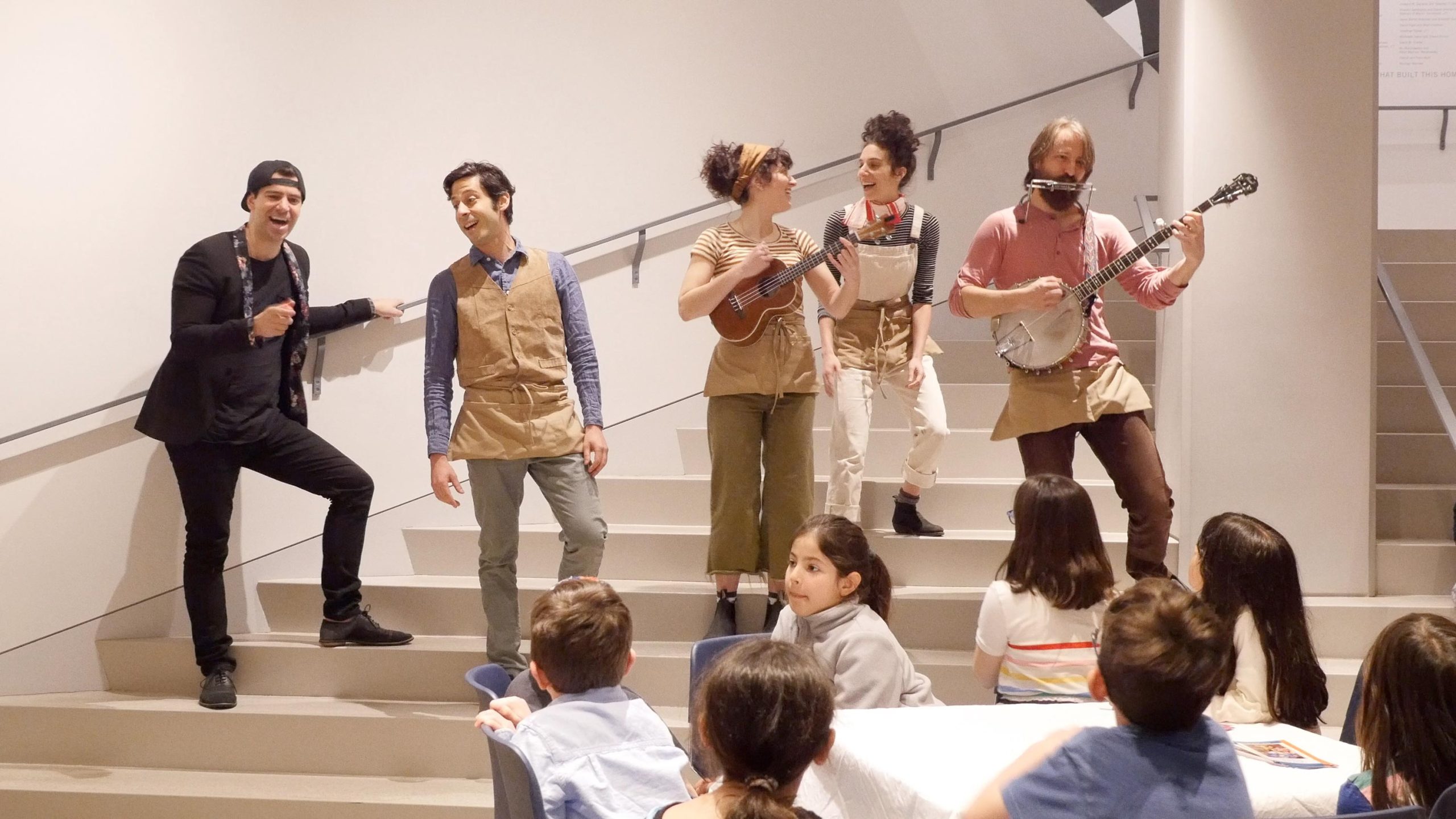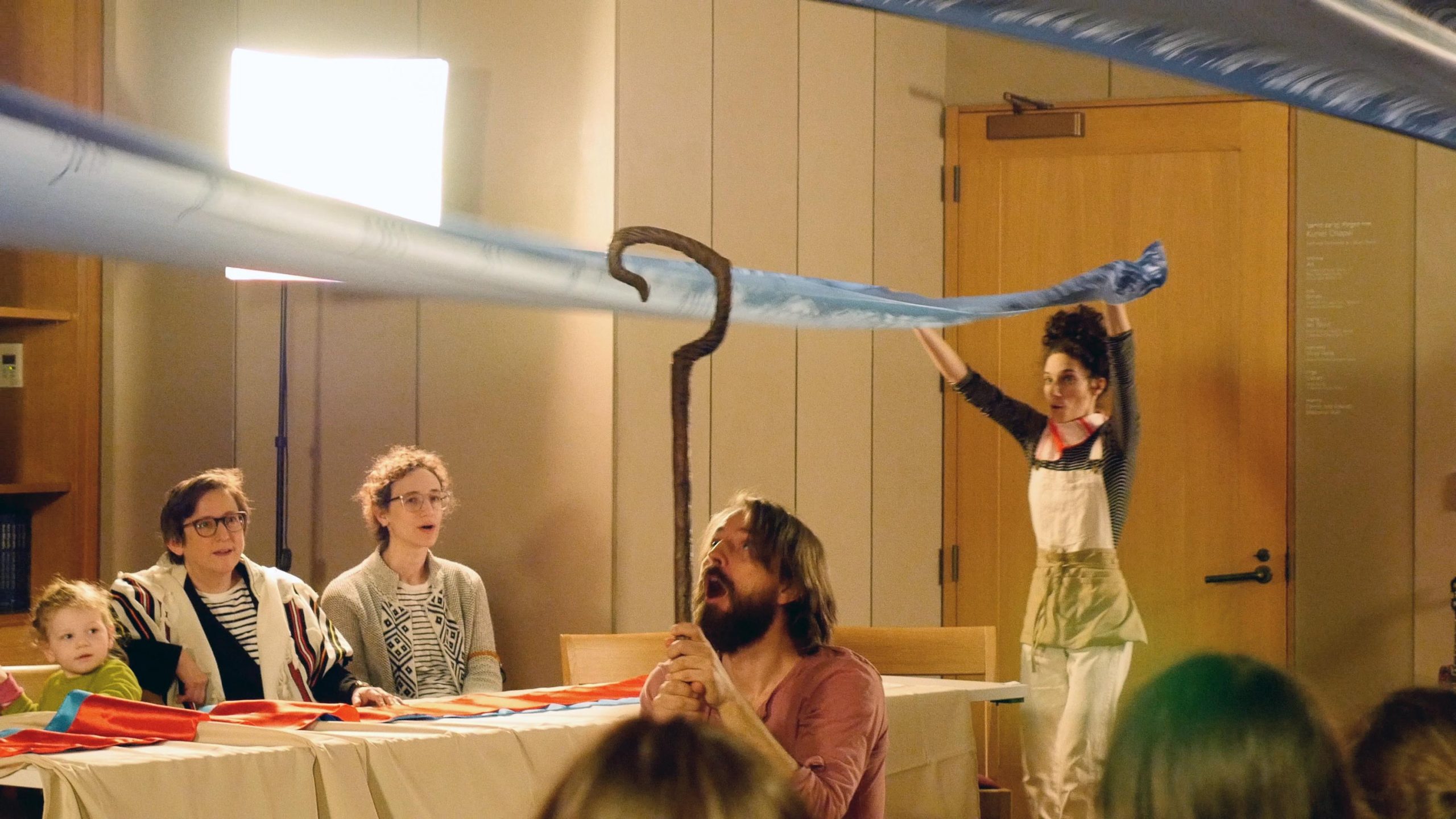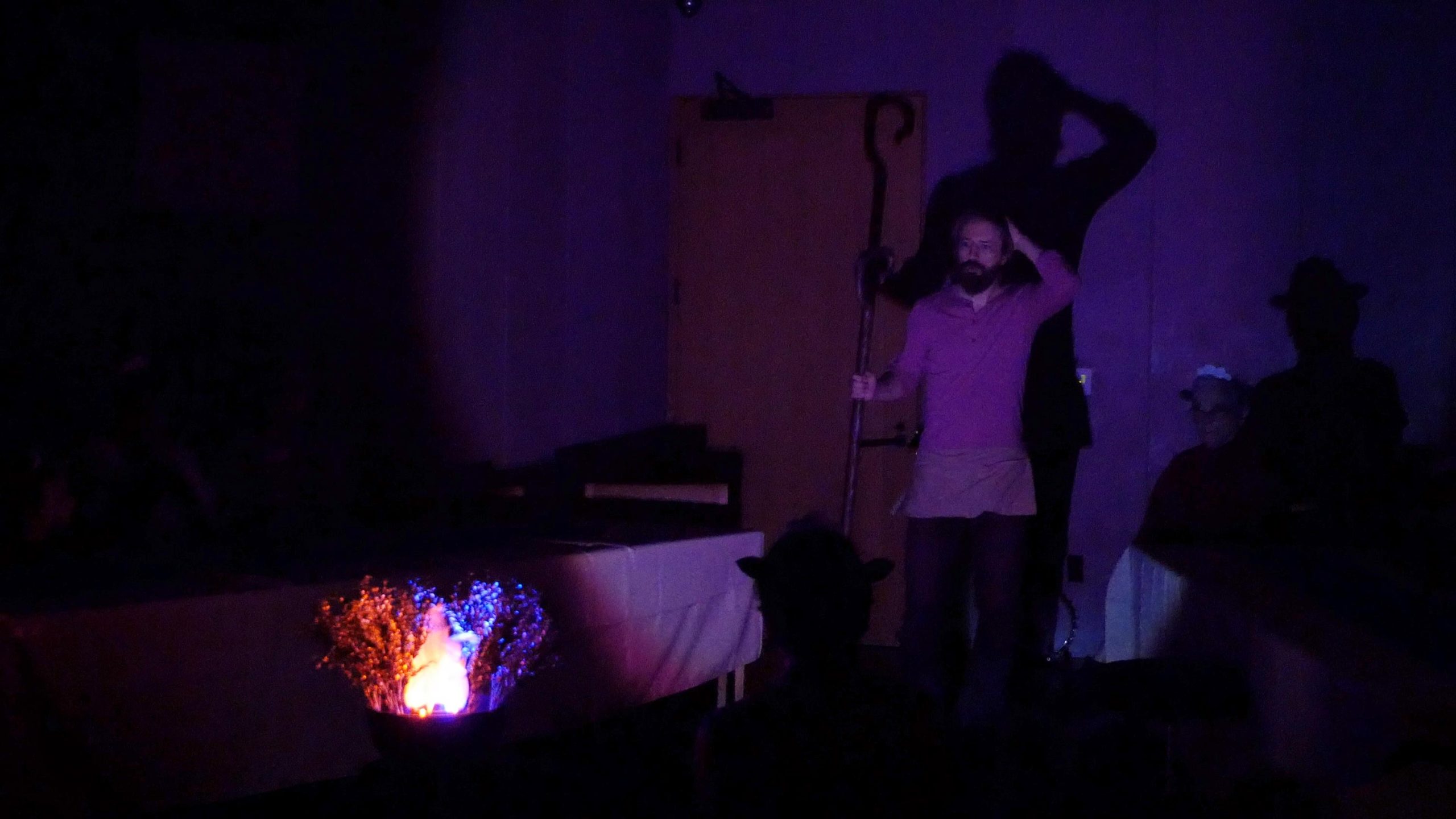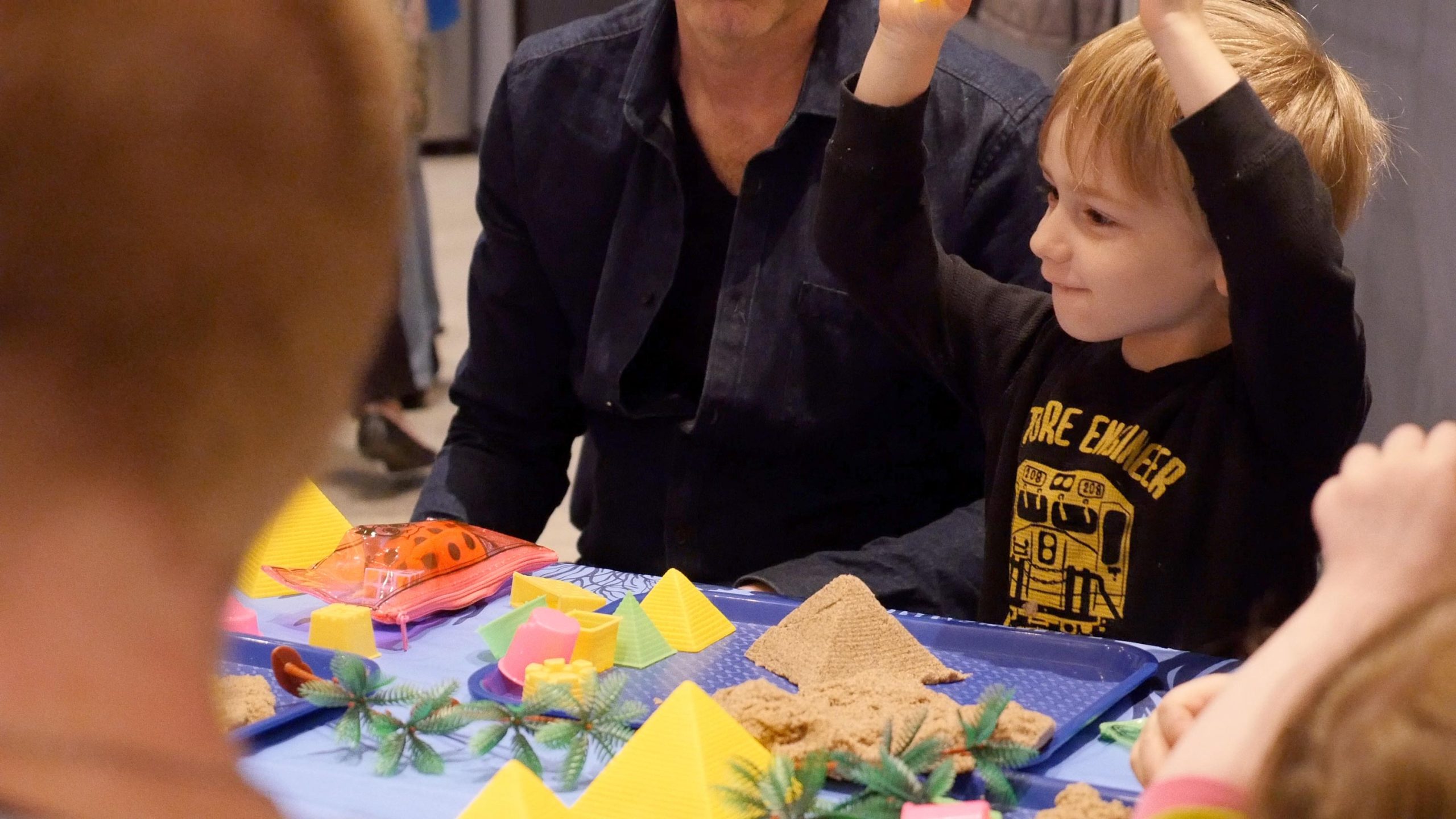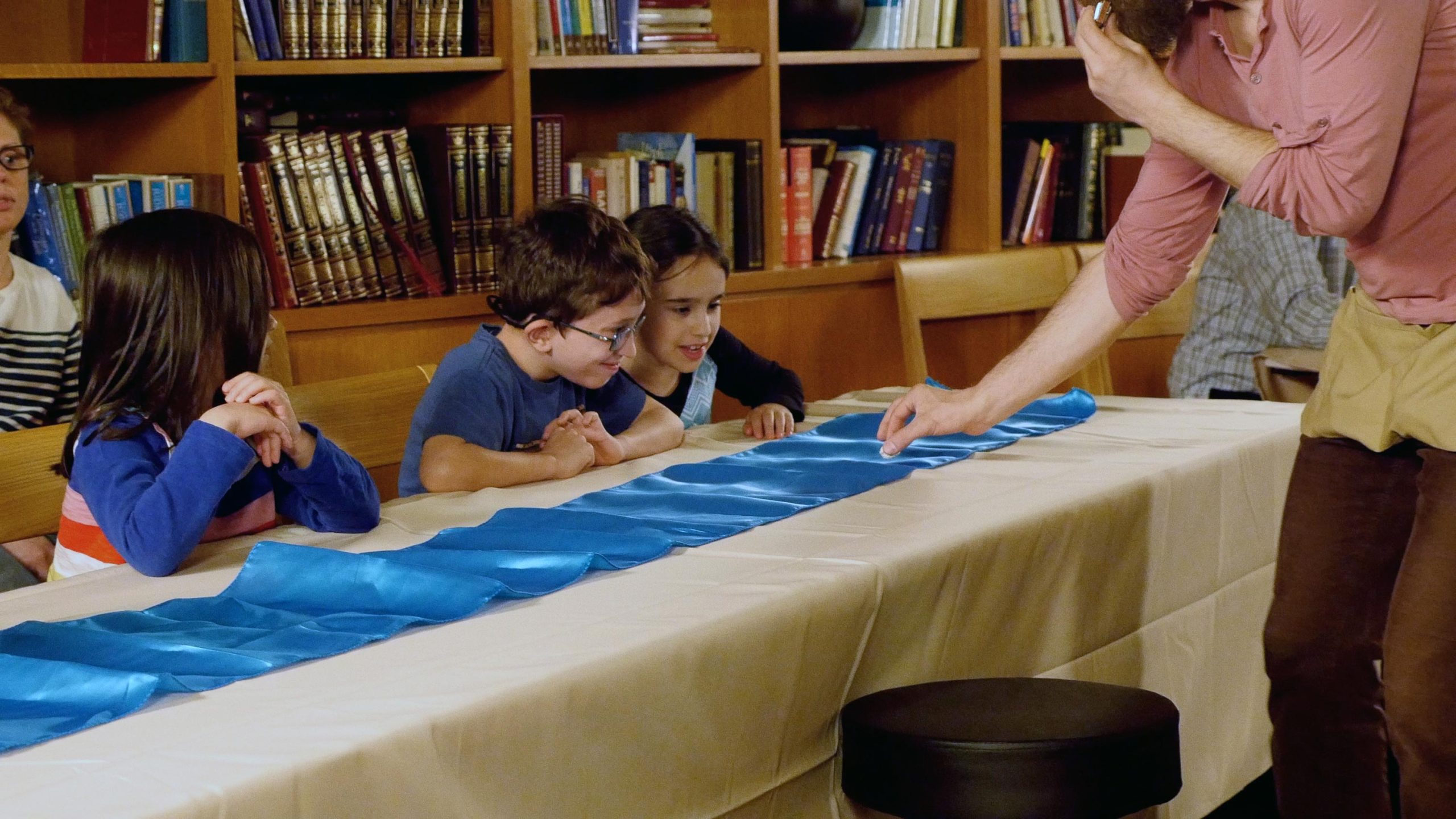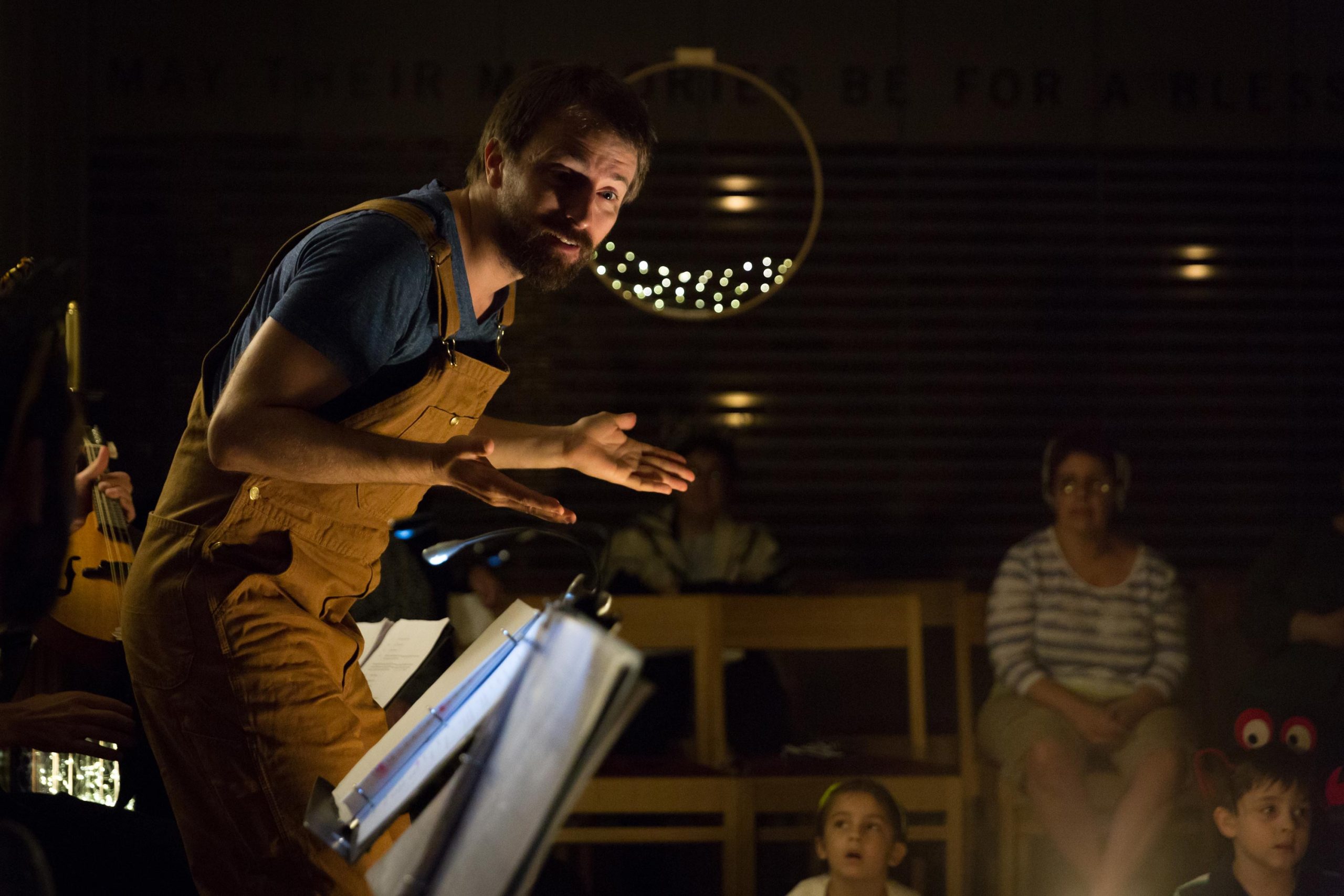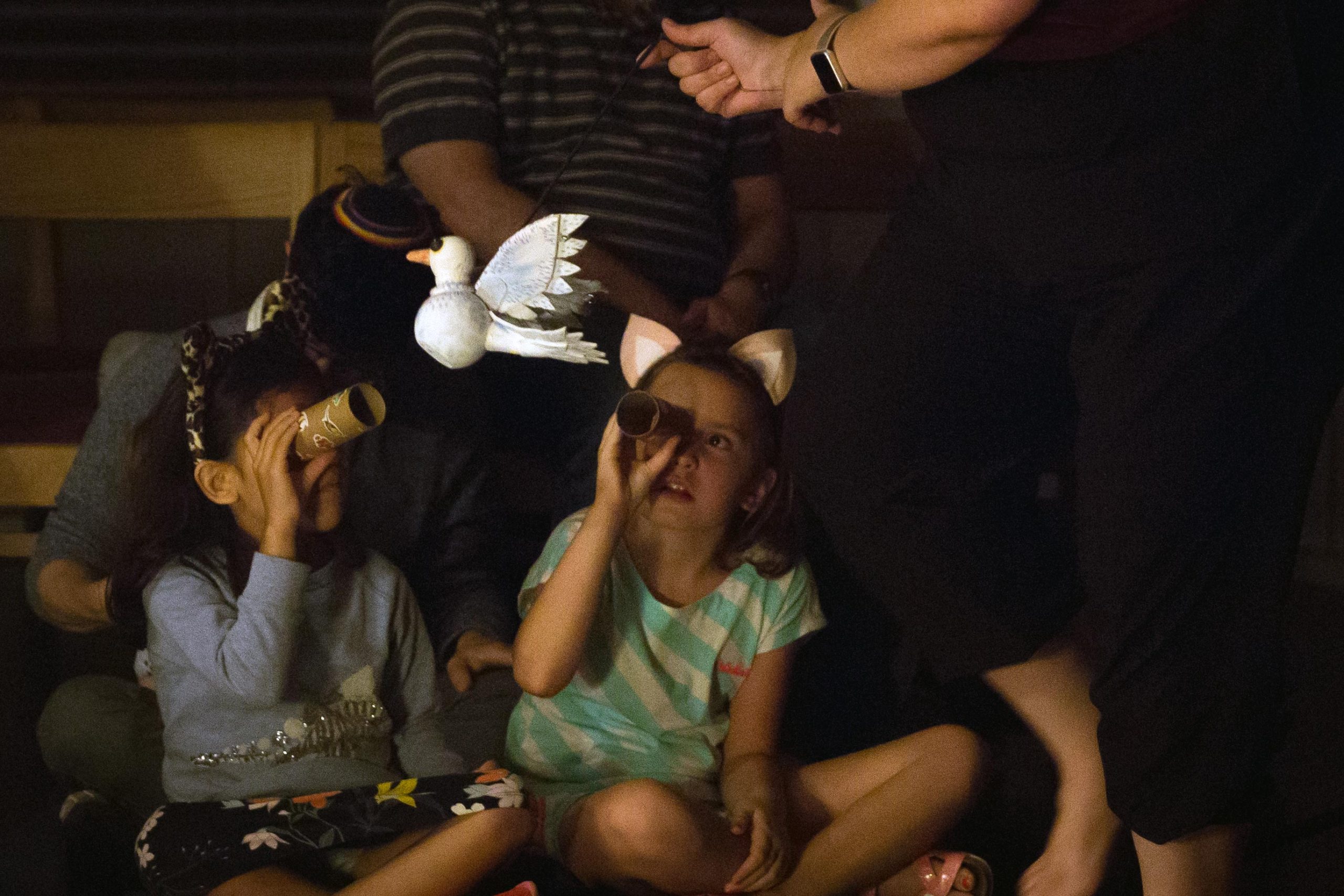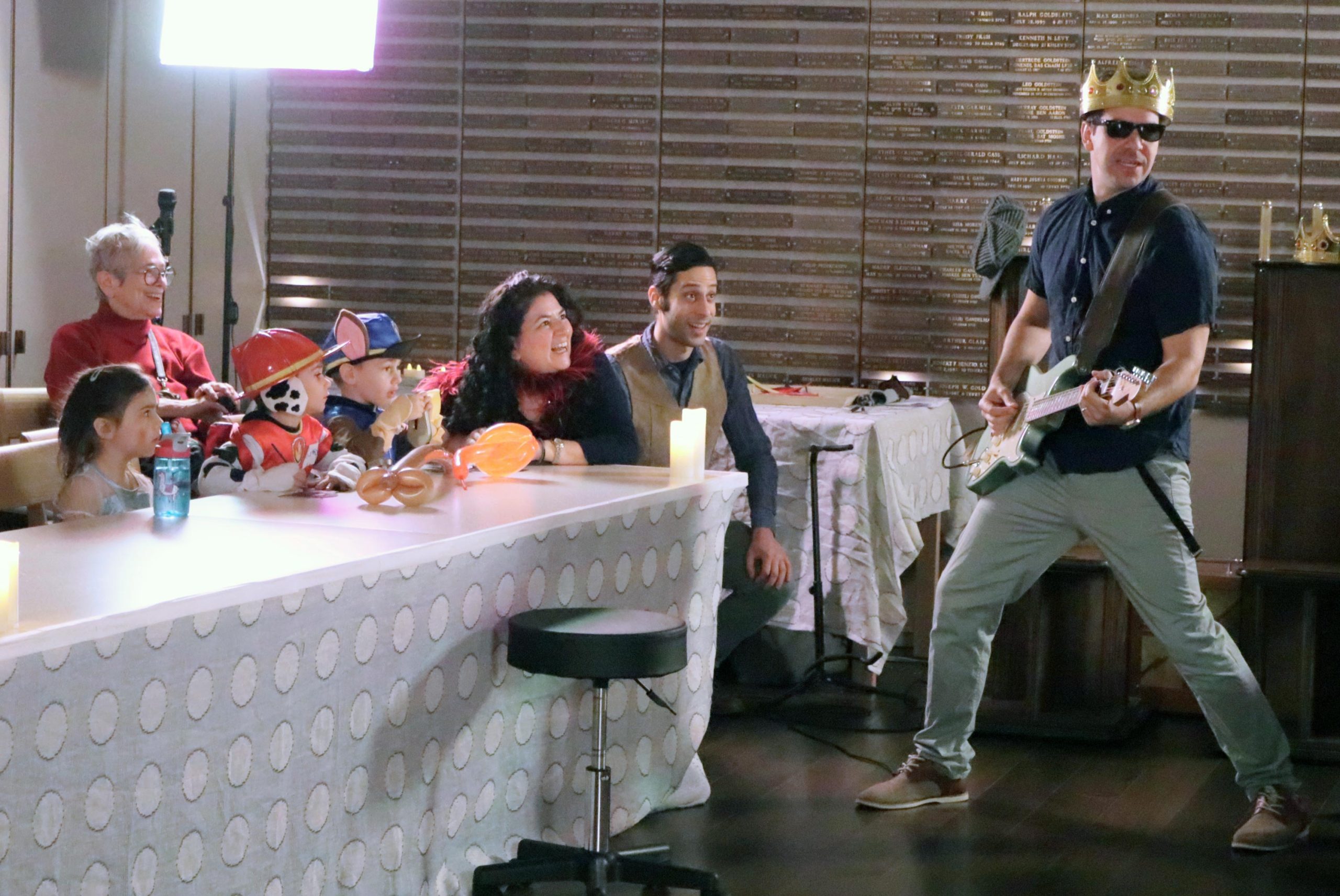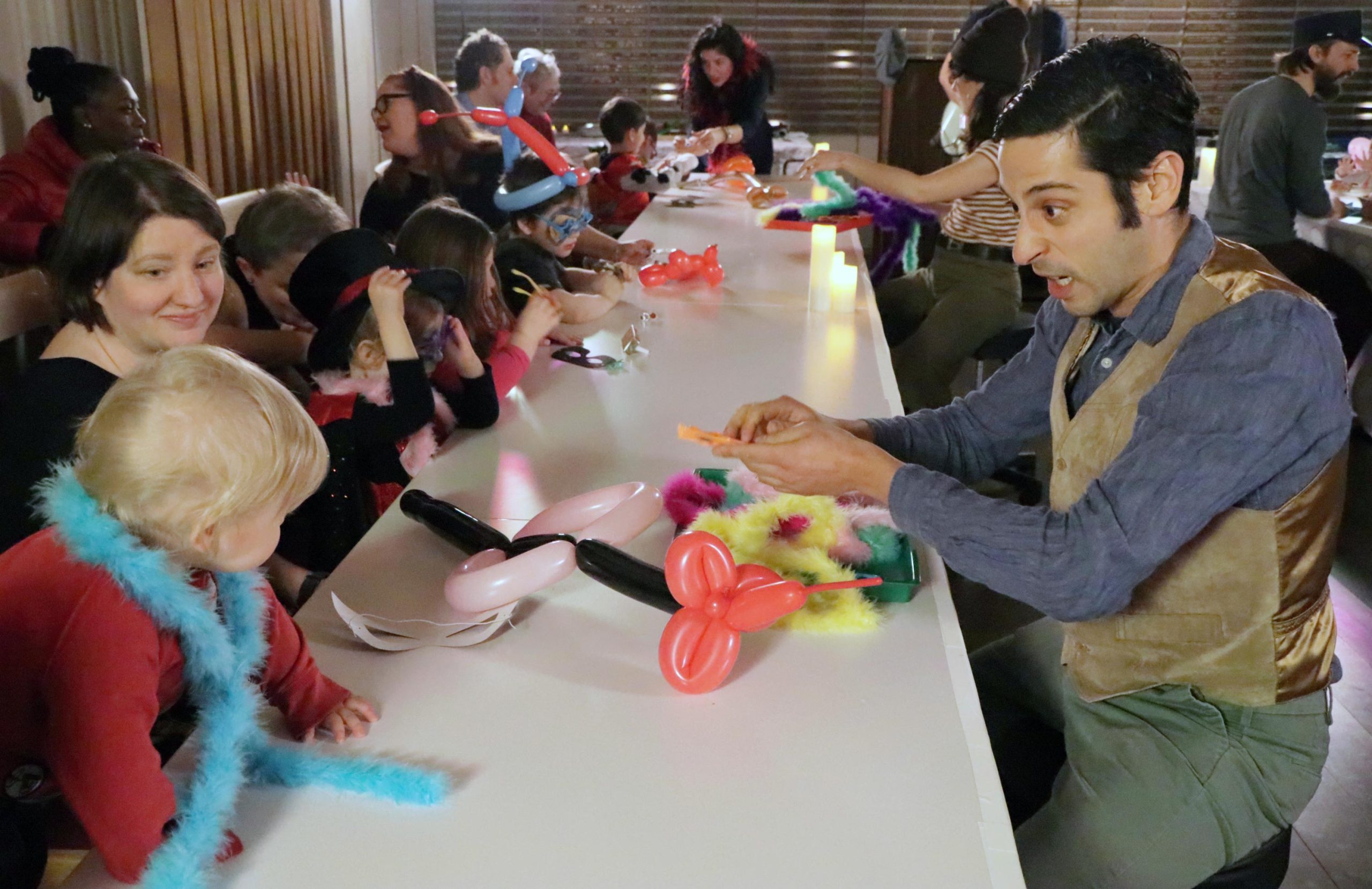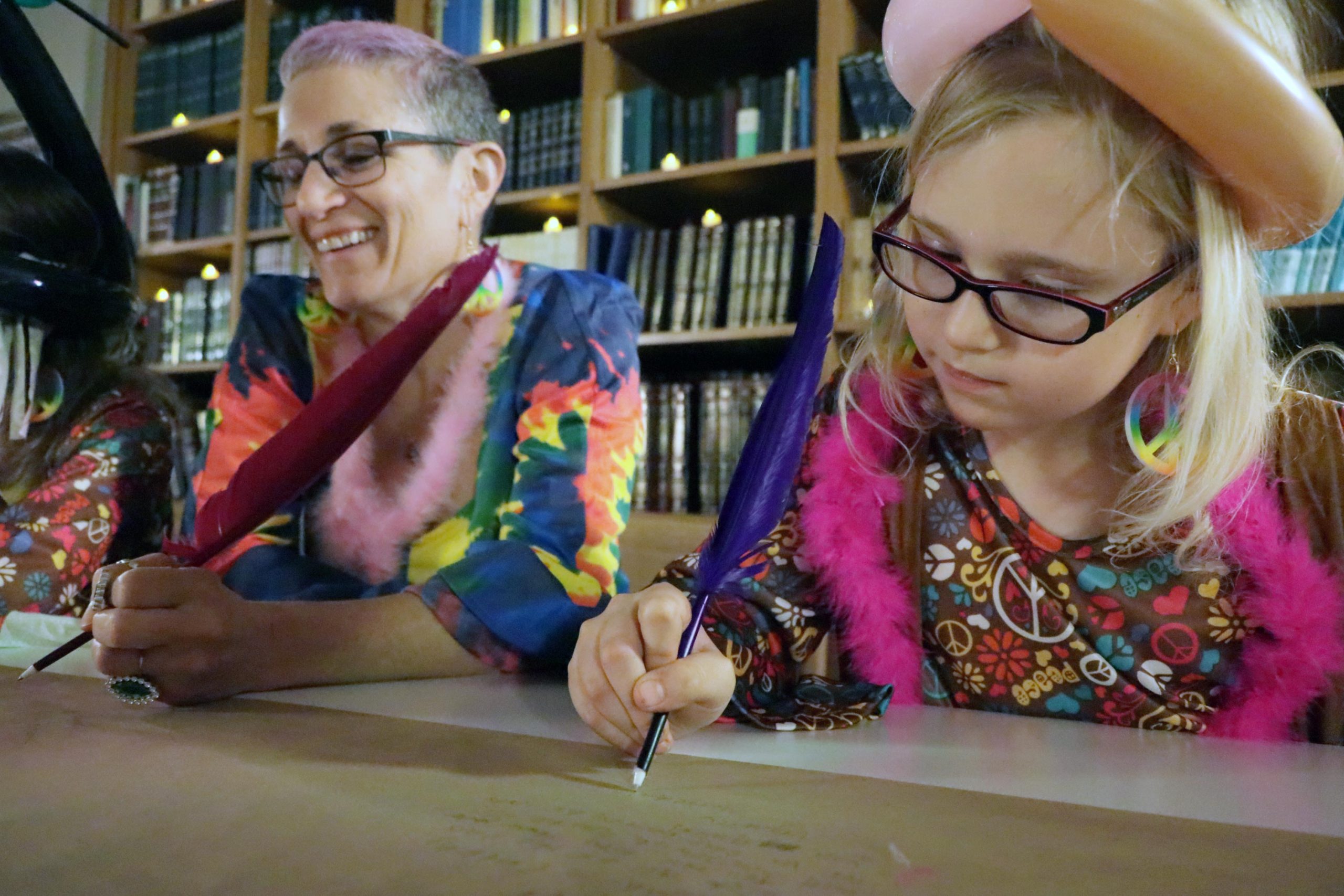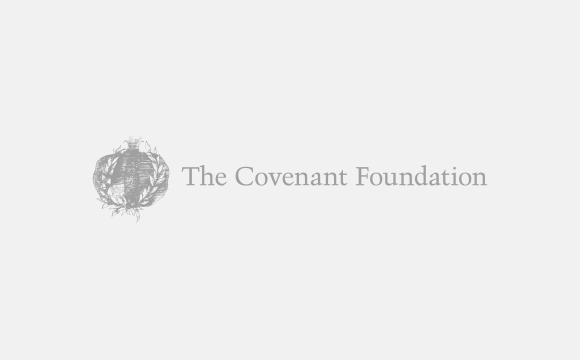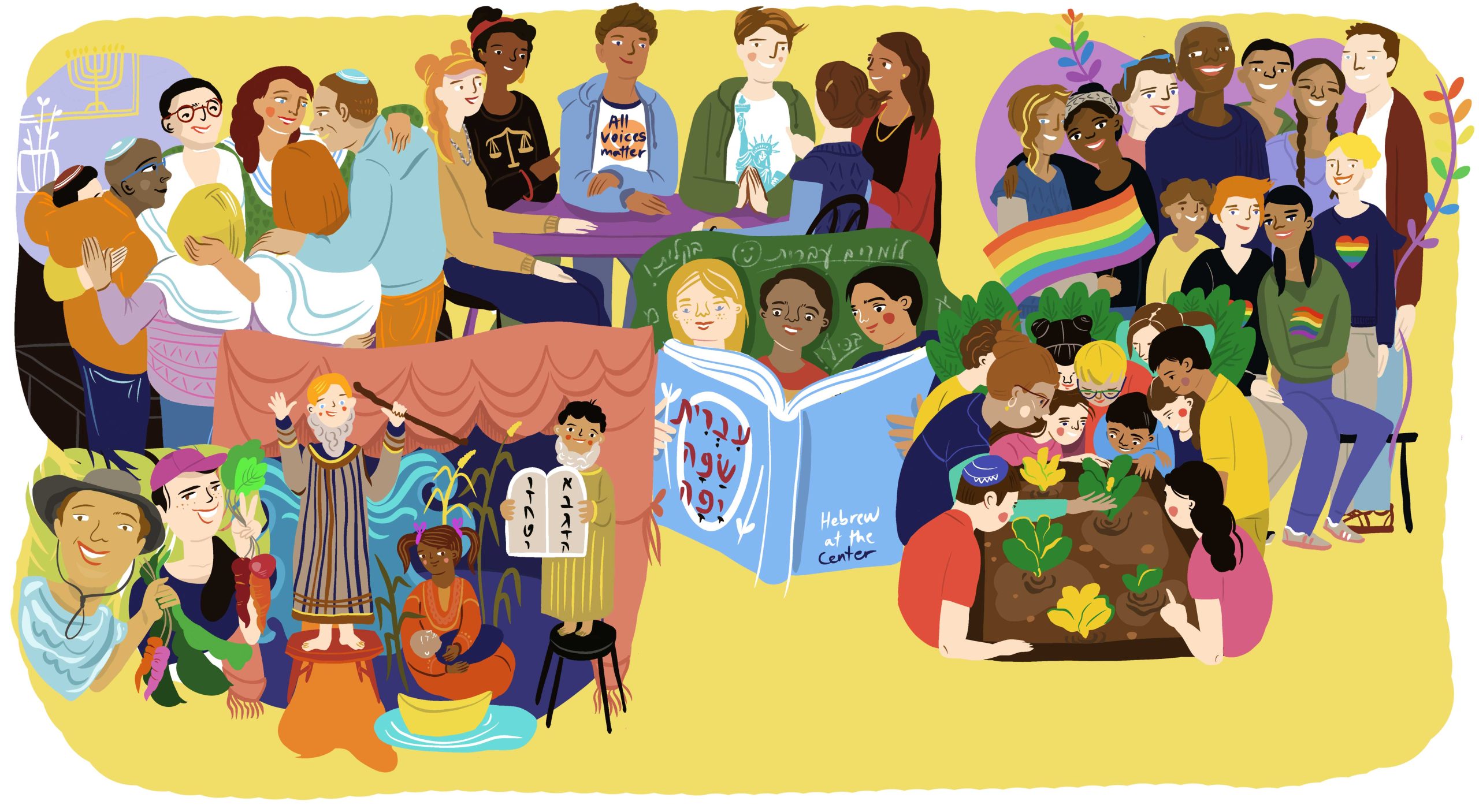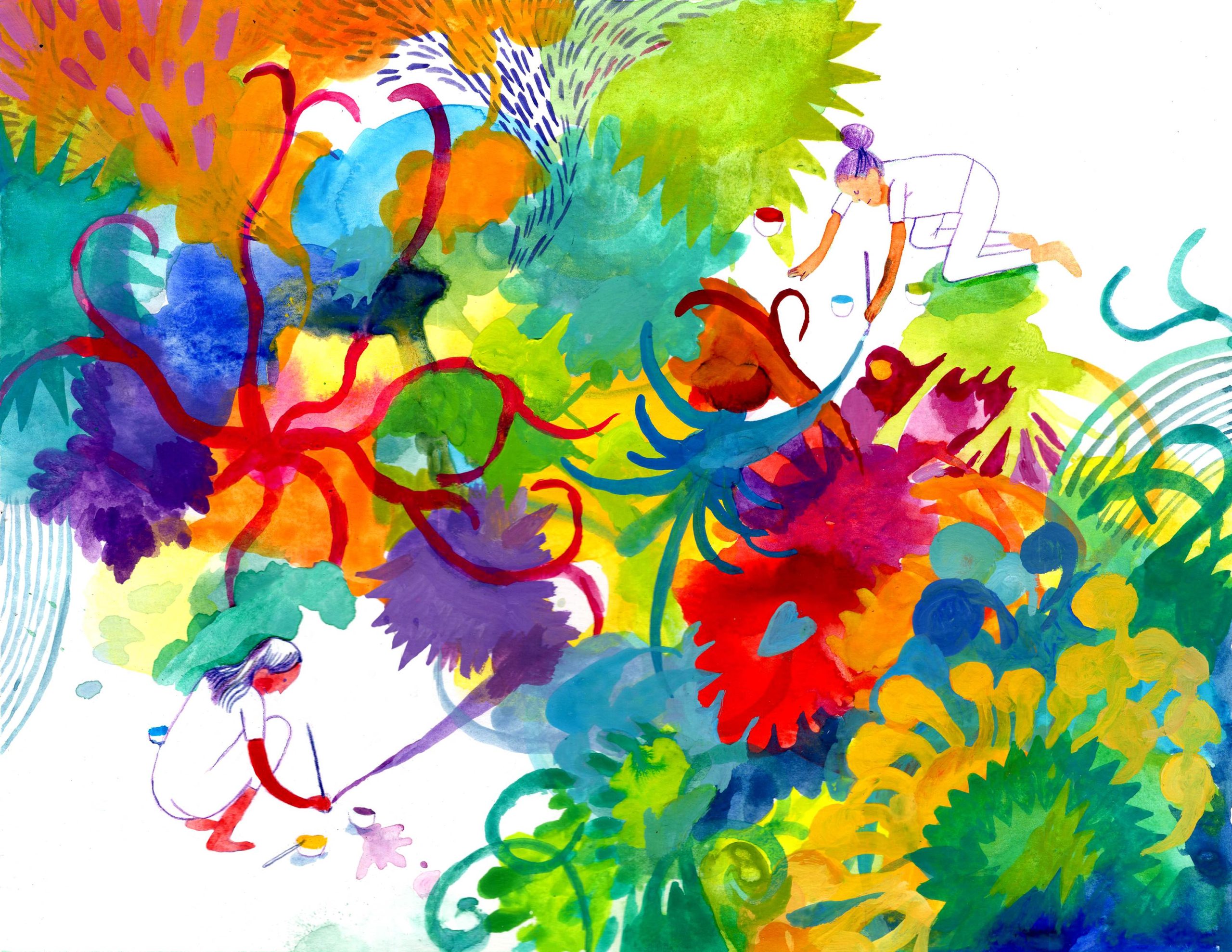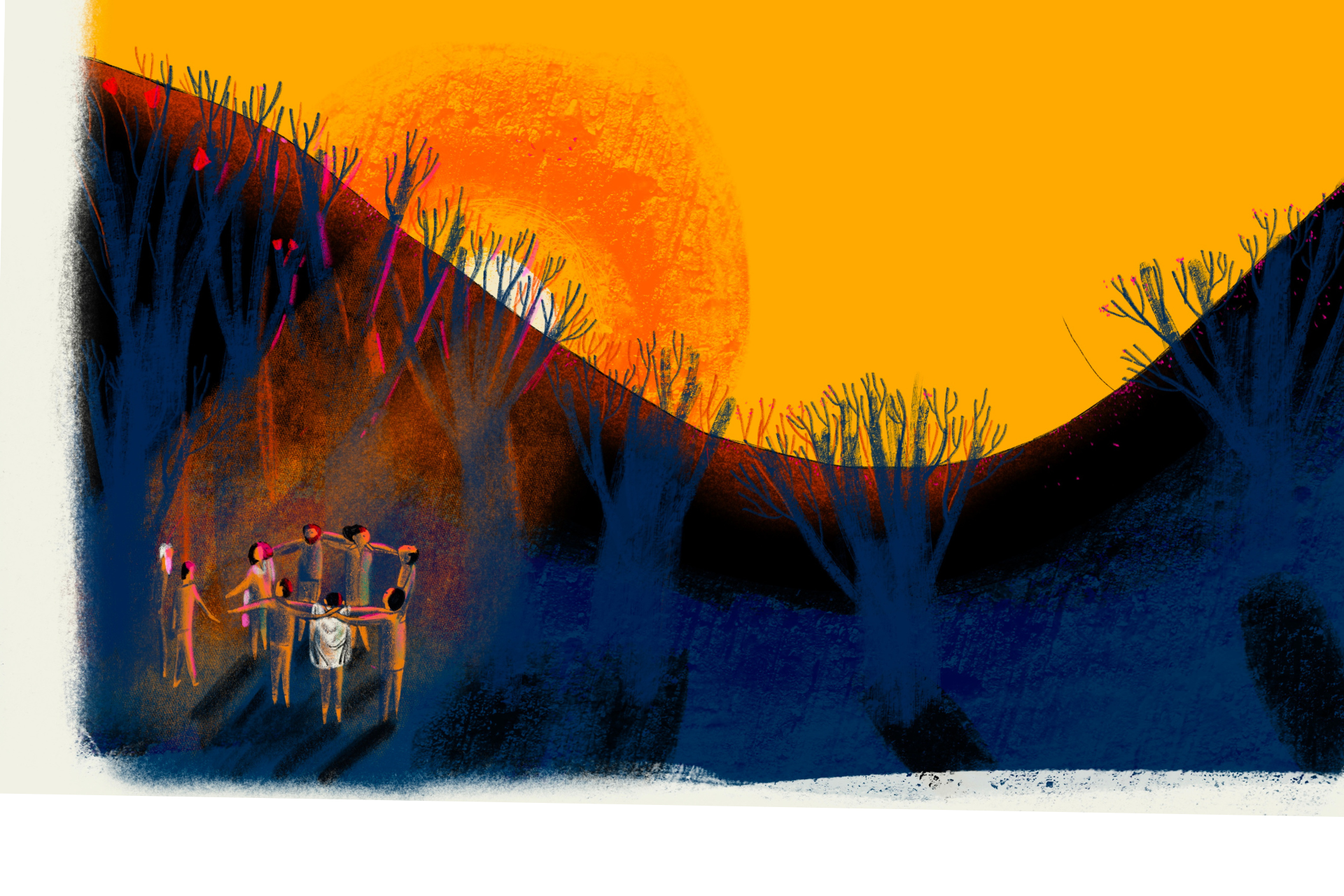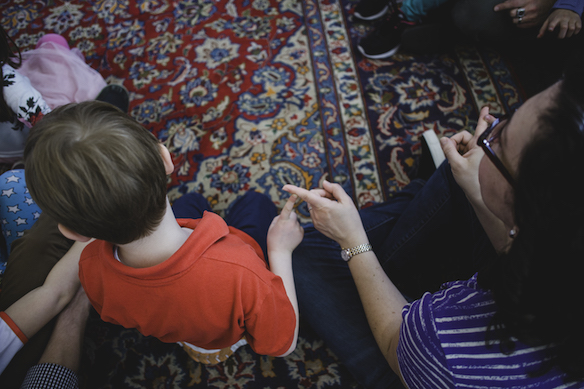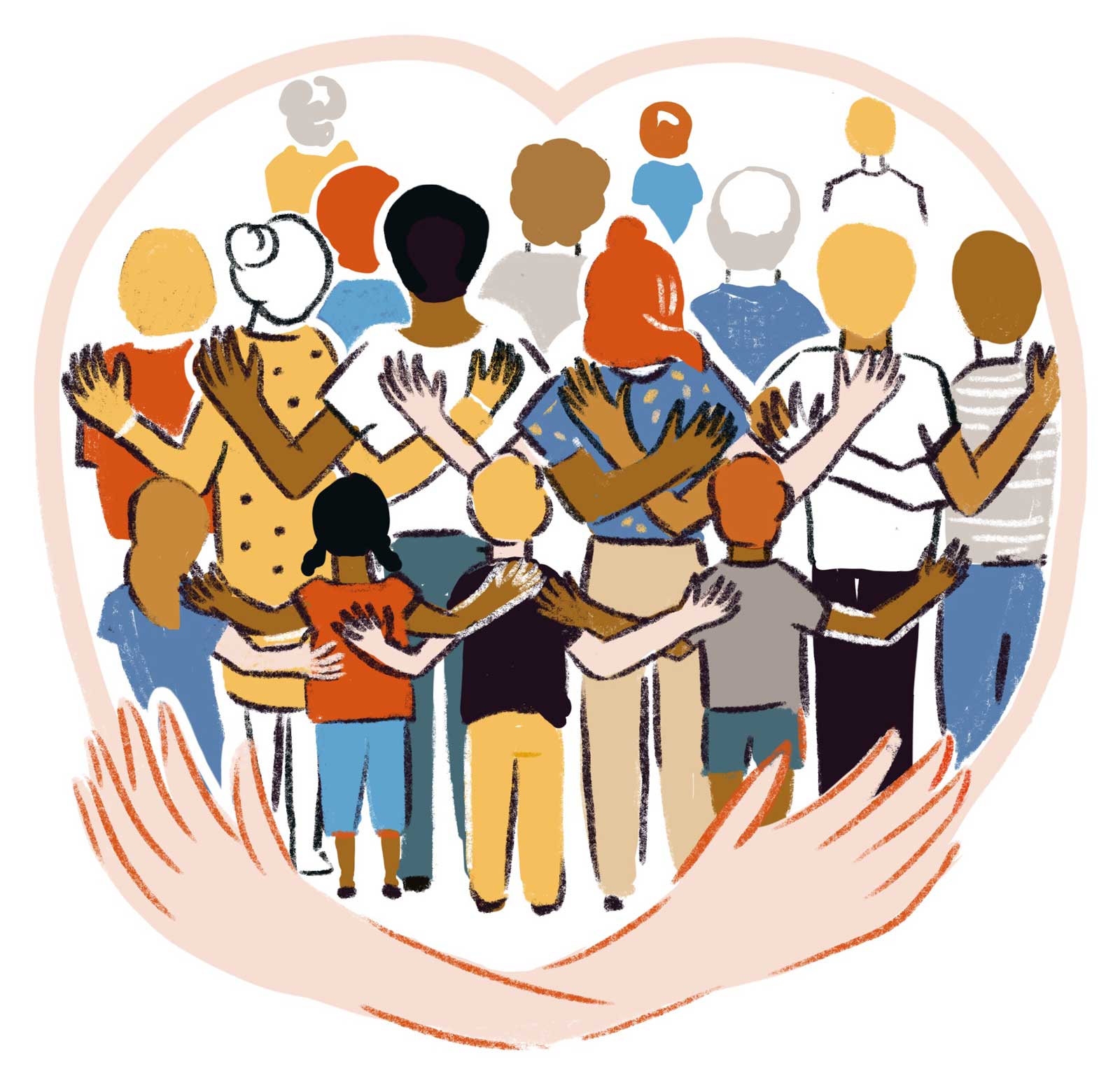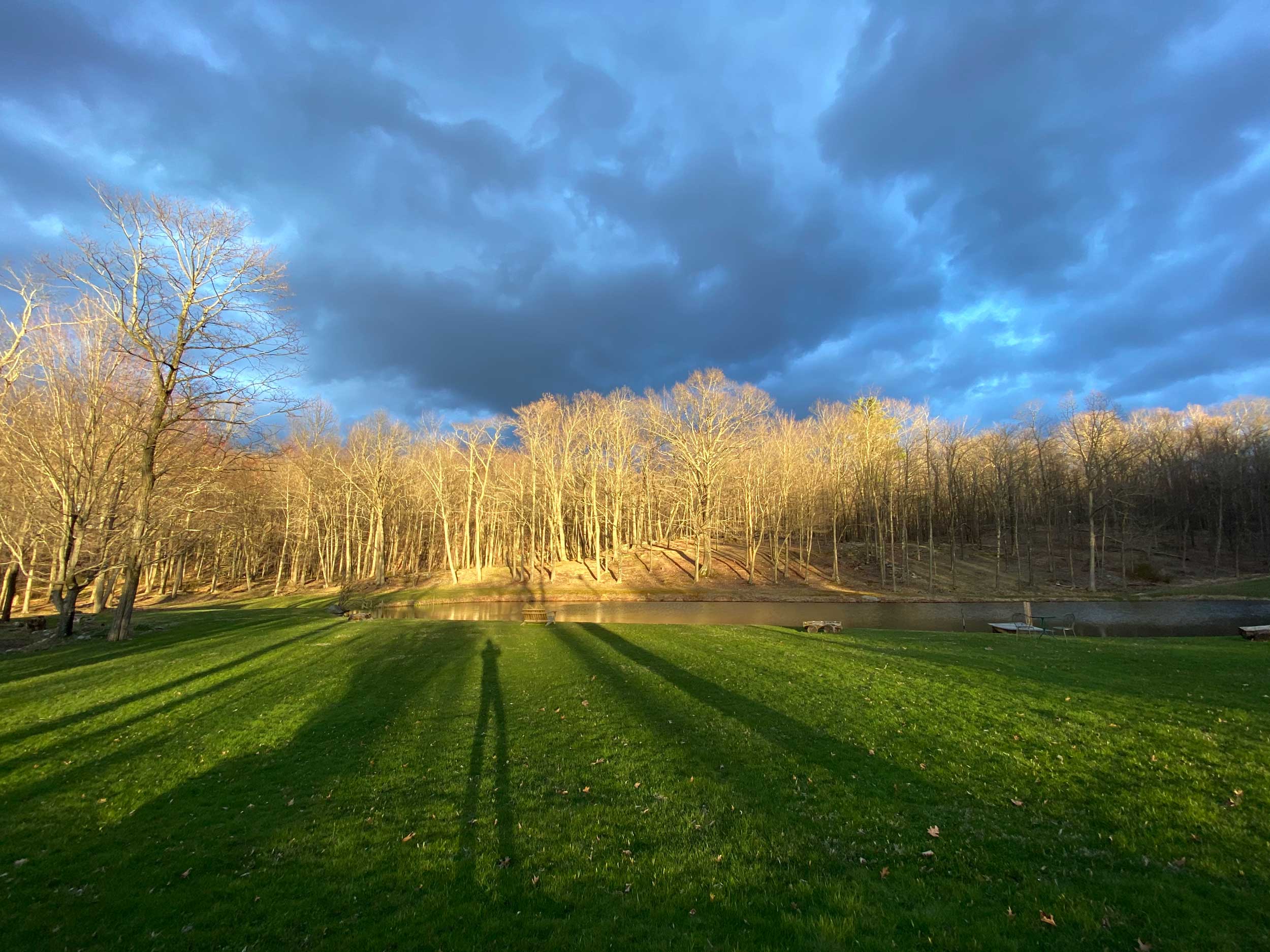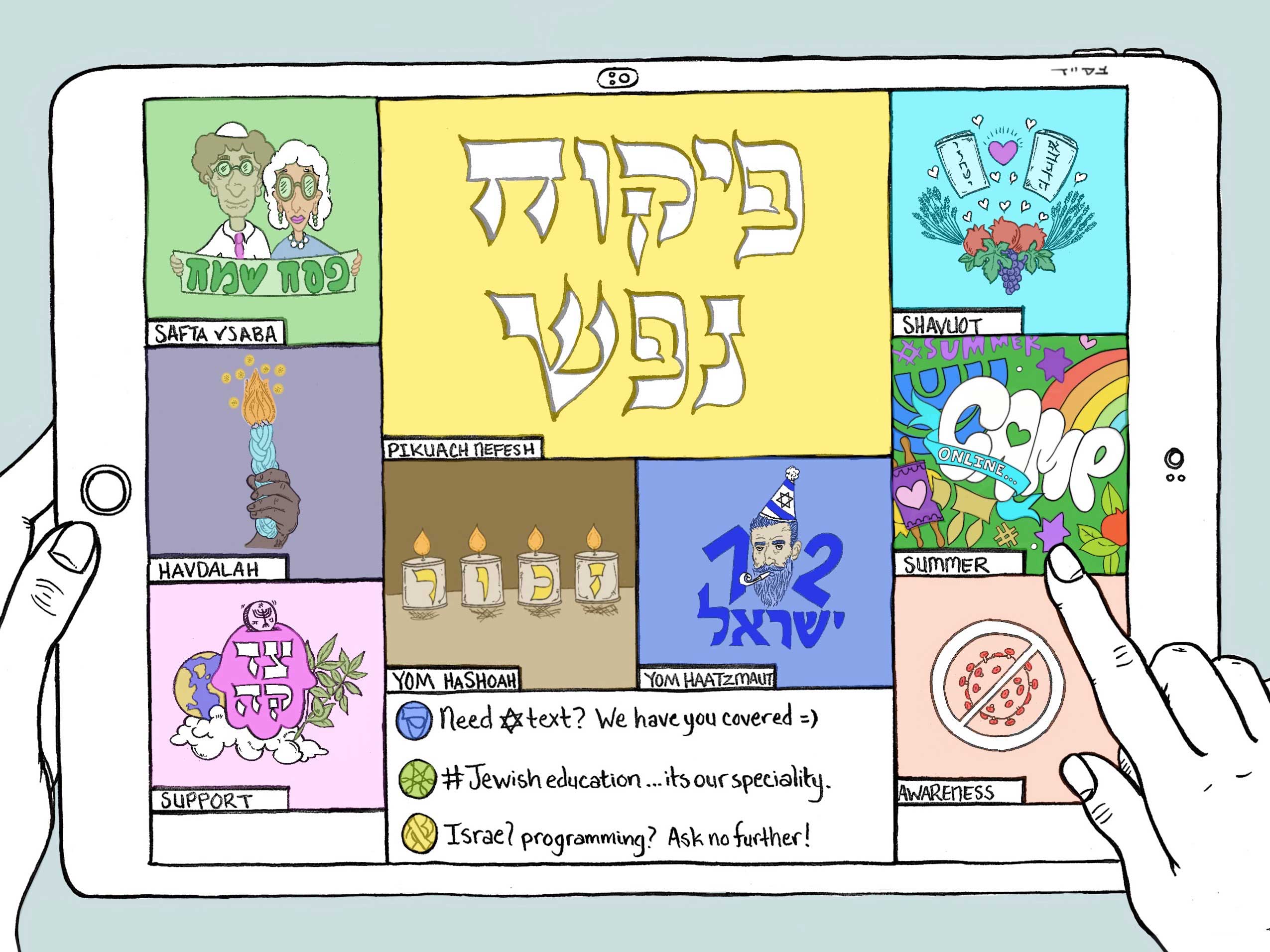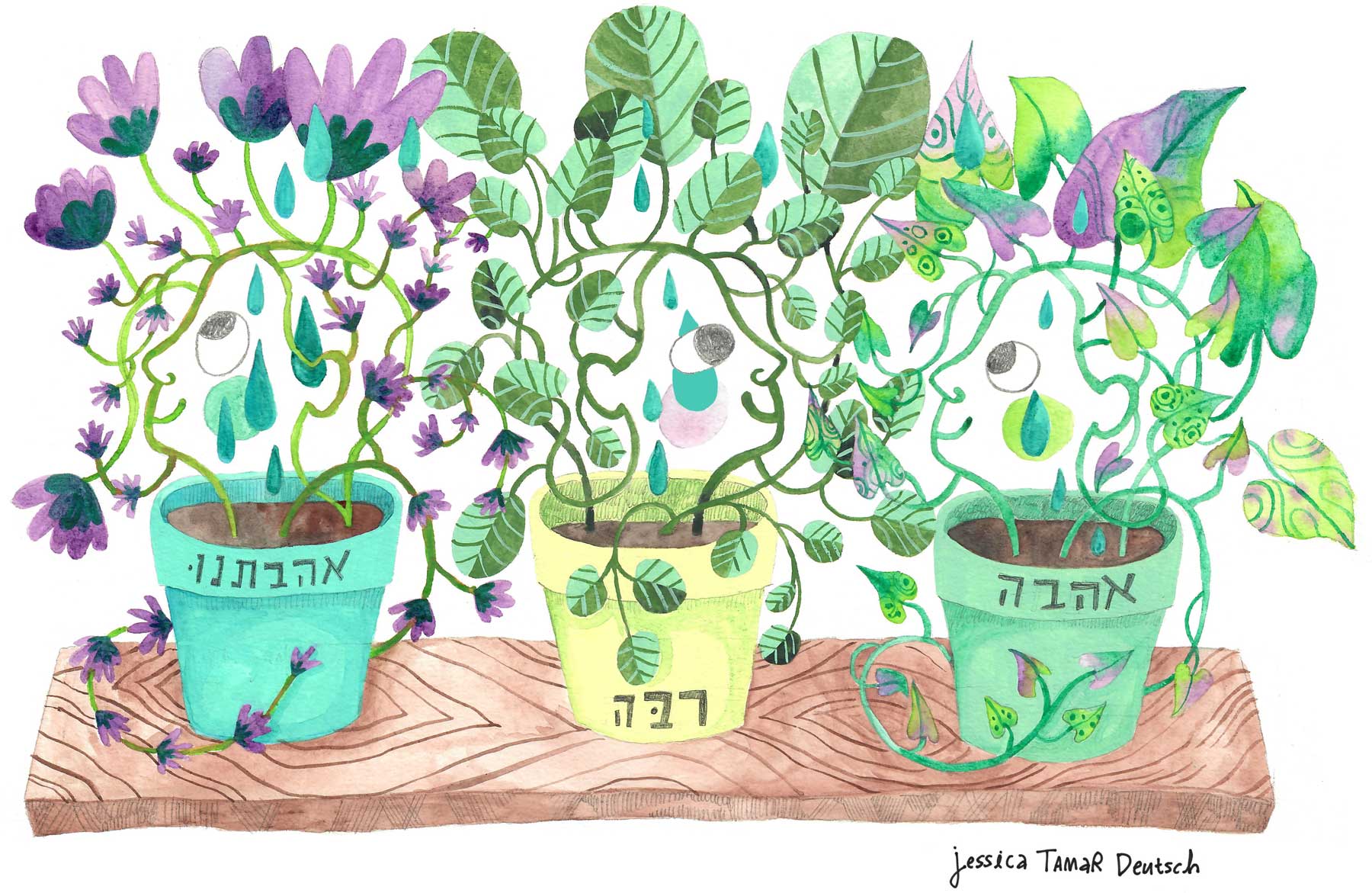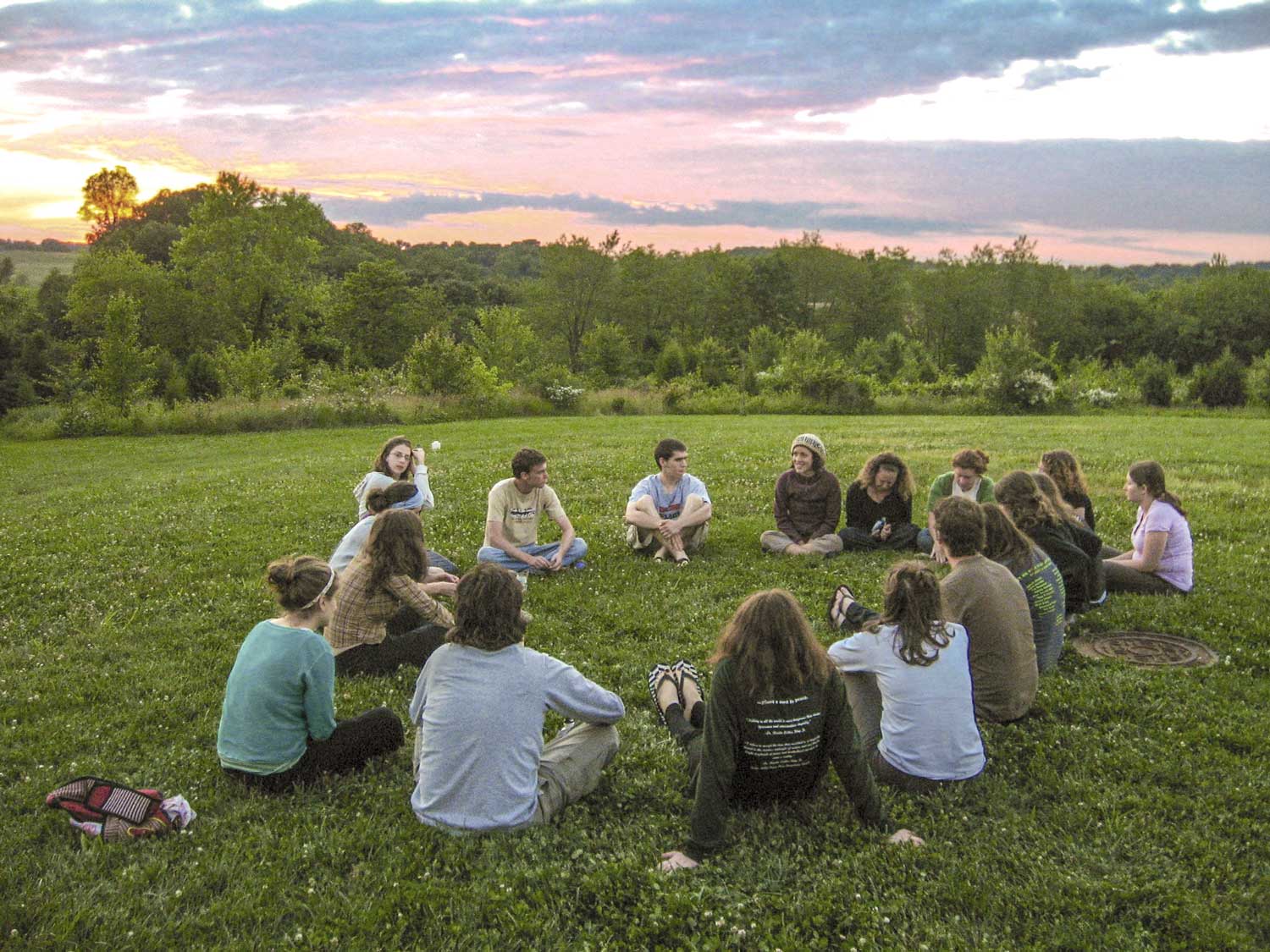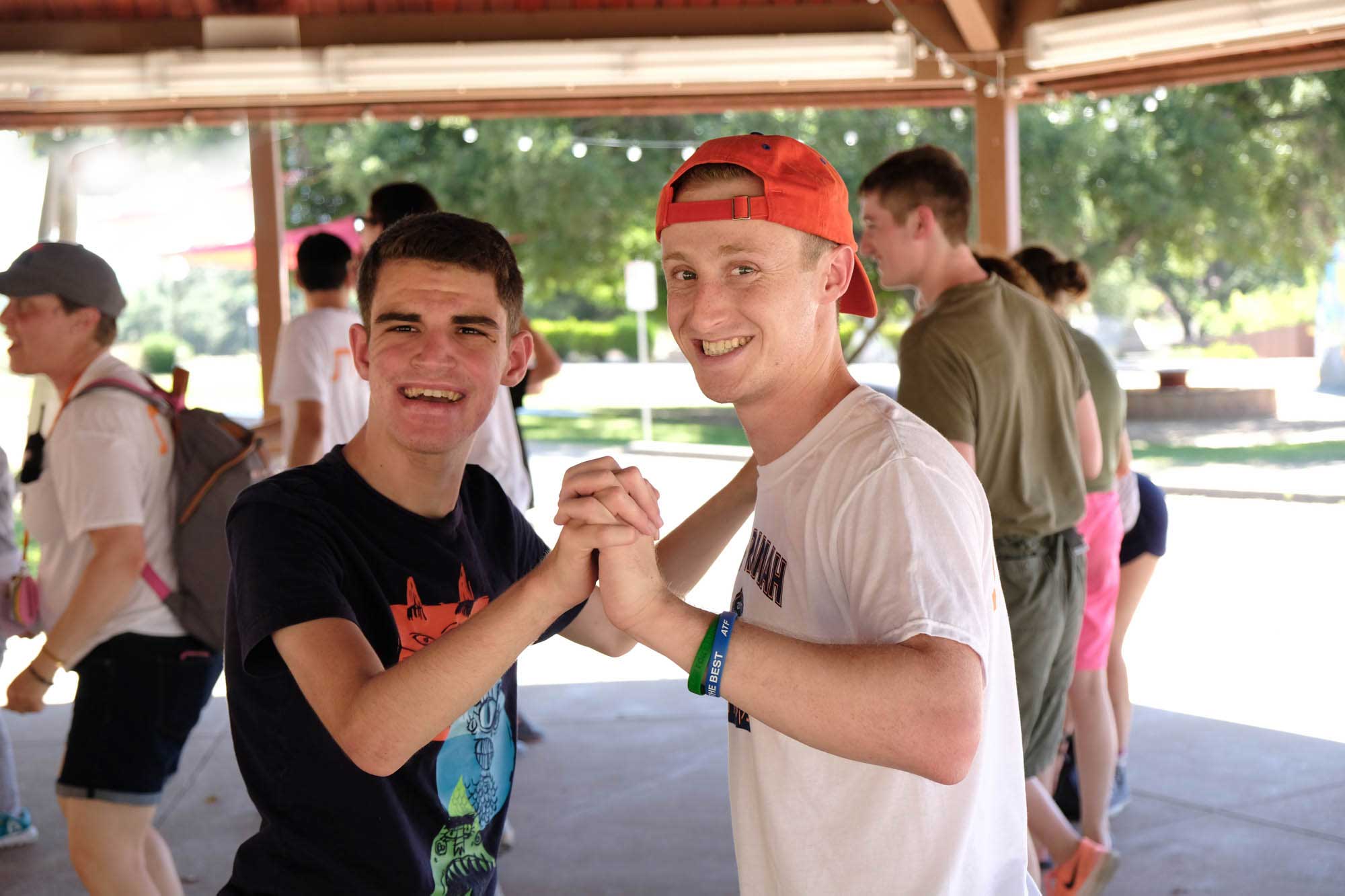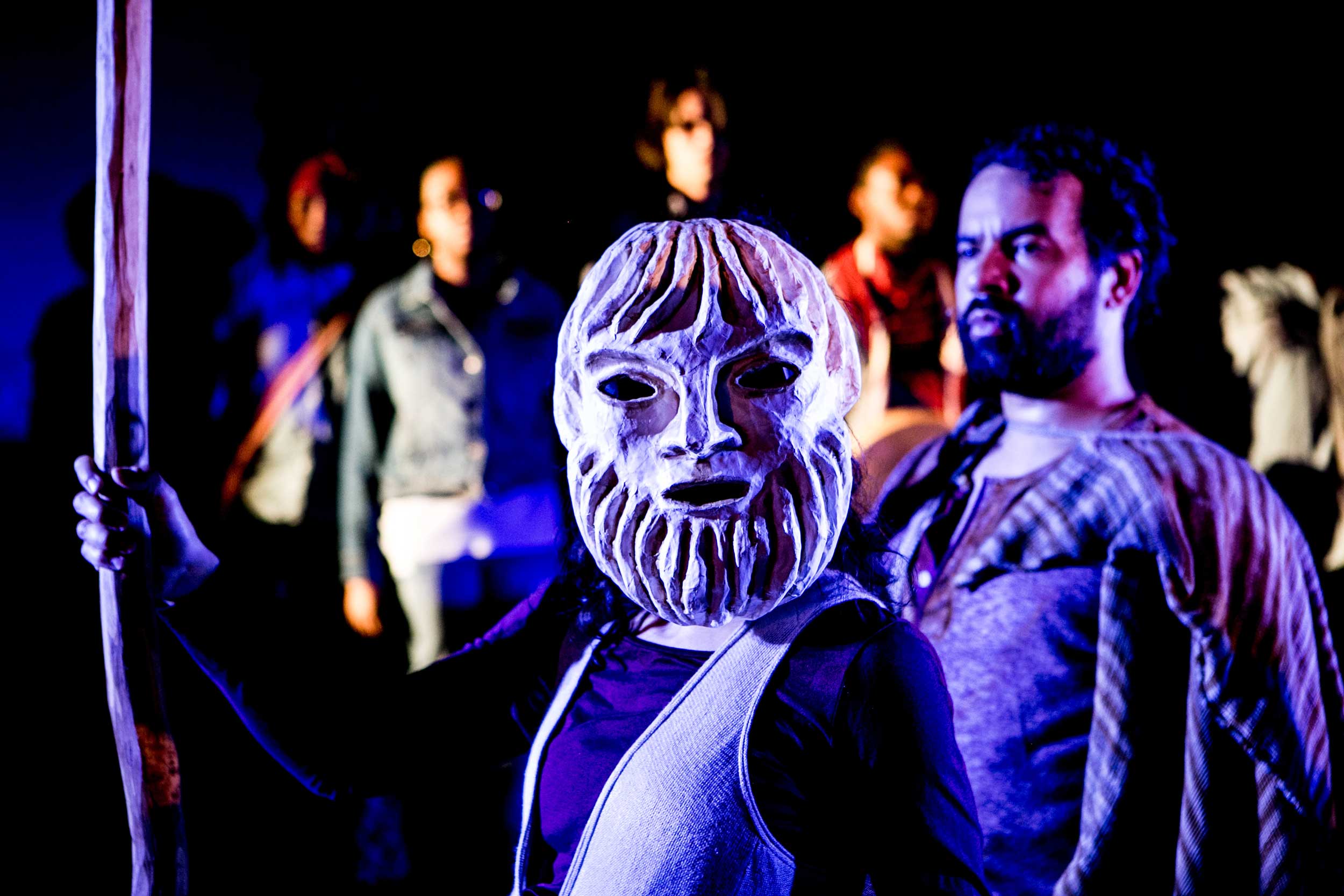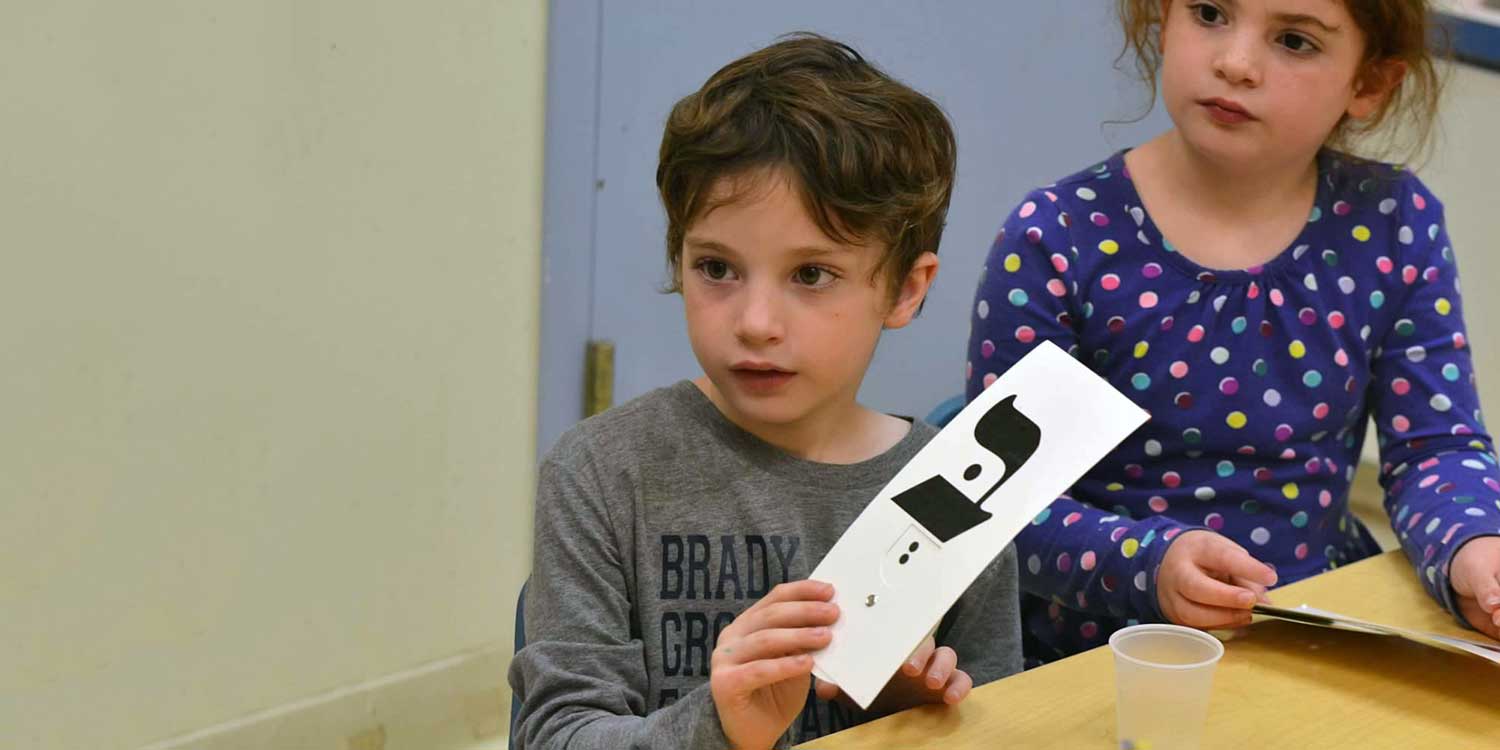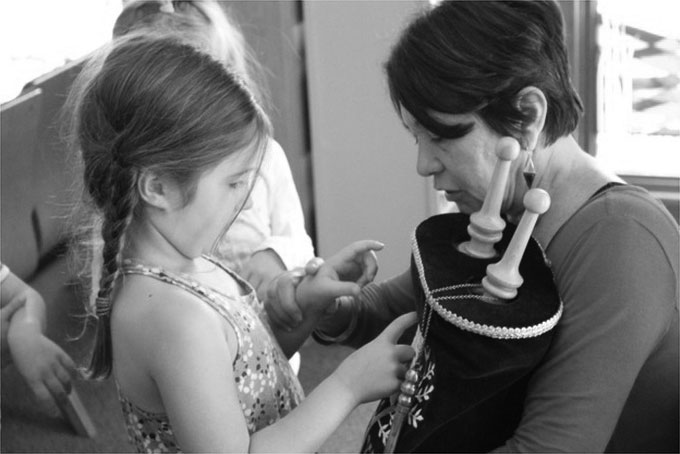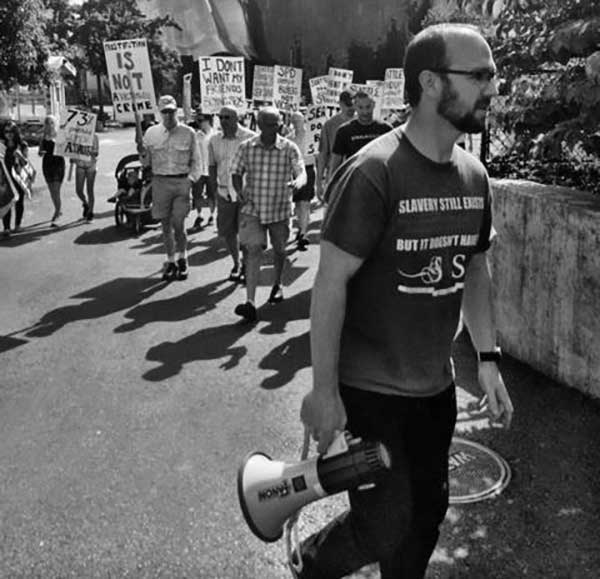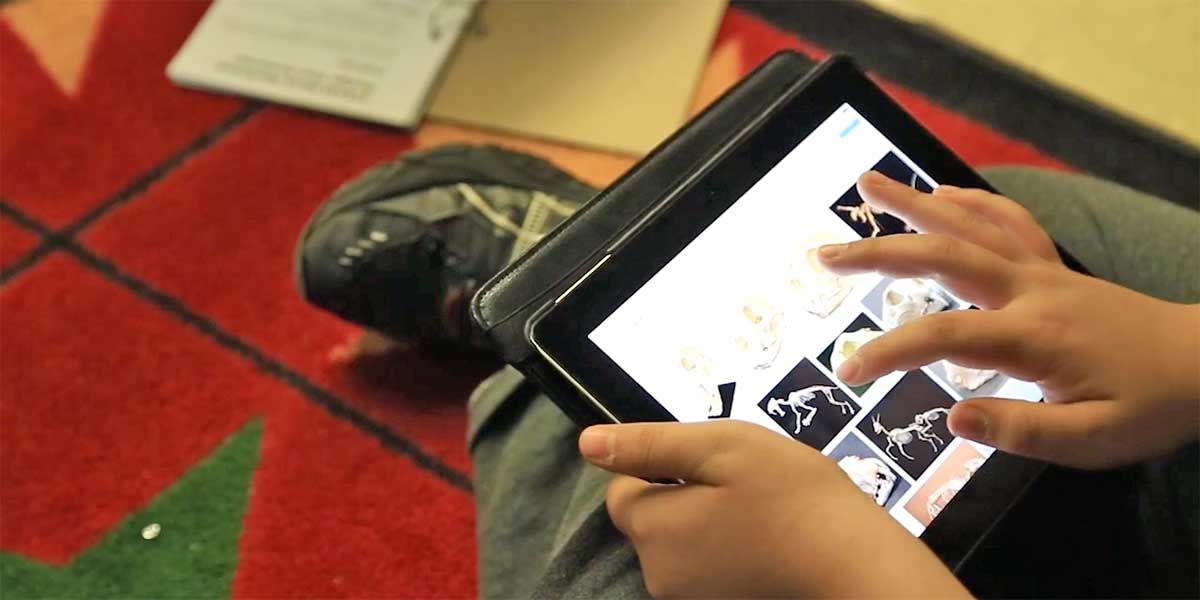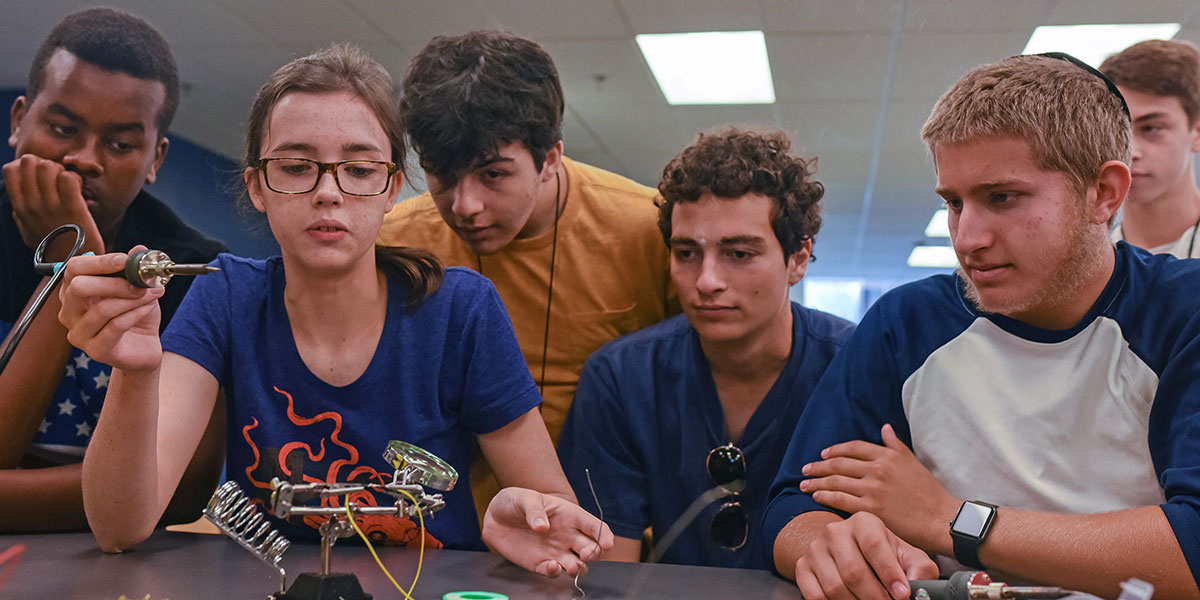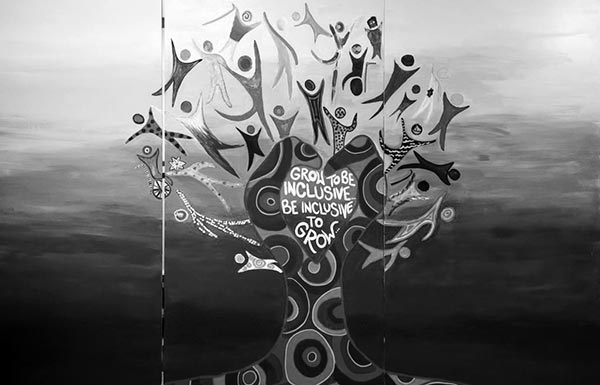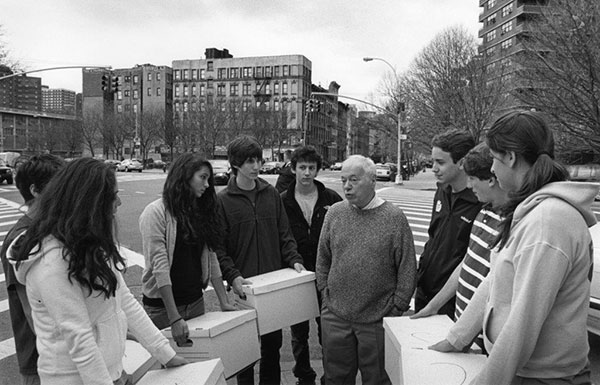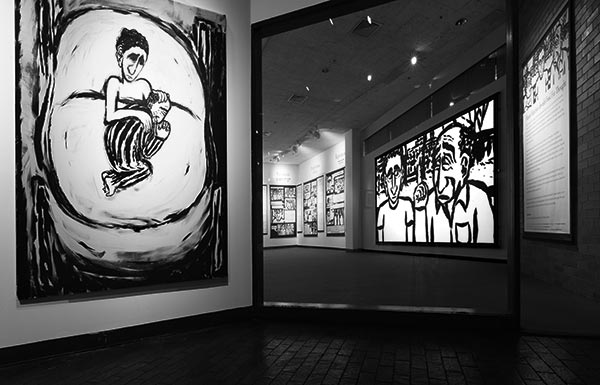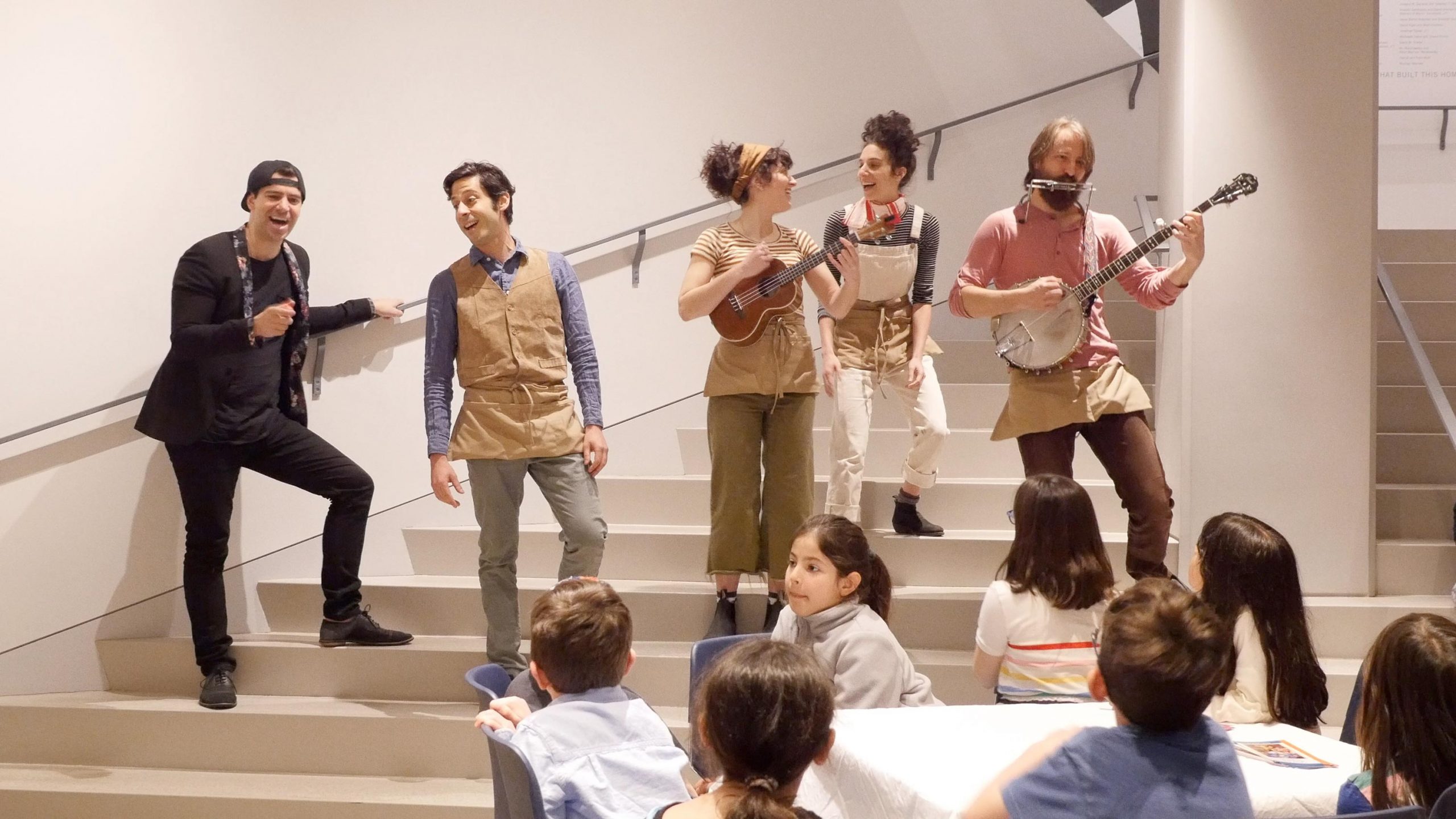
ARTICLE Theater Magic: How CBST is Putting Family Engagement on Center Stage
His husband was going to be away for the weekend, so Brian Rubin-Sowers was searching for something to do with his 3-year-old and 6-month-old daughters. Having a theater background, Rubin-Sowers was intrigued by the email he received from Congregation Beit Simchat Torah (CBST) about an immersive theatrical experience for young children and their grownups. He decided to check it out. What he discovered that weekend, he says, was simply “magical.”
The new program from CBST, New York City’s LGBTQ synagogue, is called Aggadah Adventures. CBST first piloted an Adventure – the story of Noah in an experience titled Under the Rainbow – in June 2018 over Pride weekend. This year, supported by The Covenant Foundation, CBST created and held two new Adventures: Purim-themed Behind the Mask and Passover-themed Down the Nile. Both Adventures were filled to capacity, serving over 100 participants over three engagements for each one.
When CBST was founded in 1973 as one of the first gay synagogues in the United States, the demographic reality of the community meant that its founders did not see the need for family and children’s programming. Spurred by progressive legislation in more recent years, expanded families-by-choice options, and a dramatically increasing number of LGBTQ individuals and couples choosing to have children, families with young children now represent over 20% of CBST’s 600 member households. To better serve this rapidly growing demographic, in 1994 spiritual leader Rabbi Sharon Kleinbaum created the first monthly “tot Shabbat” program. Then, in 1999 CBST established a Hebrew School that, over the next 10 years, grew into the robust Limmud B’Shabbat education program for children ages six to 18 and the bi-monthly Alef-Bet Shabbat service for babies, toddlers, and preschoolers. However, more recently, the leadership of the synagogue felt that there was still a gap in CBST’s early childhood programming.
Rabbi Yael Rapport, Assistant Rabbi at CBST and Project Director for Aggadah Adventures, was looking for a more immersive and experiential program that parents could have a genuine stake in, and experience alongside their children rather than just watching from a distance. When Jonathan Shmidt Chapman, who serves as the Executive Director of Theatre for Young Audiences/USA and now also serves as Project Director for Aggadah Adventures, asked her what it might be like for families to walk into Noah’s ark in a Jewish Theatre for the Very Young (TVY) experience, Rabbi Rapport knew they were onto something.
“No one else in the congregational world is doing anything like this,” said Rabbi Rapport.
The international theatre model of TVY has become increasingly popular over the past decade as a powerful way to convey narrative in an age-appropriate way to children under five and their families. Drawing on many special TVY techniques – including immersive storytelling, multi-sensory elements, 360-degree learning environment, and small participant size to maximize interaction between artist-educators and participants – Aggadah Adventures has emerged as an exciting program to connect CBST families with young children to Jewish stories, holidays, learning, and wisdom.
“The key words for us were family engagement,” Rabbi Rapport explained. “But we also want to be creating very deep roots within a child’s experience and memory about Jewish story, ritual, and community, and it didn't make sense to do that without the grownups who came with the kids.”
Aggadah Adventures is anchored by CBST’s commitment to using the arts and music as vehicles for connection to Judaism. The medium of theater adds to the depth of Jewish learning that participants can experience. Rabbi Rapport explained how Aggadah Adventures has the profound ability to take participants to a higher level and unlock Jewish stories in the sense of both pshat (surface-level, literal meaning) and drash (deeper, interpreted meaning).
“Every single time [children attend] they will be transformed, and adults will be transformed by watching their children be transformed,” said Rabbi Rapport.
This learning and transformation begins the moment kids and families arrive in the lobby. Before even entering into CBST’s chapel – the Aggadah Adventures performance space – children are given a role in the story and are invited with their families to participate in a hands-on activity with a direct connection to the upcoming experience. For the Purim Adventure, children made masks, and for Passover, they built pyramids using kinetic sand. Following the activity, the artist-educators break into a welcoming song and lead everyone into the chapel, with families moving in a troubadour-like procession. When participants enter the chapel, they find an intentionally designed, completely immersive environment.
“I have a background in theater so I’m always wondering, ‘What is that first moment?’” said Beth Slepian, who has been going to CBST’s High Holiday services for 15 years and has attended all three Aggadah Adventures with her 2-year-old son. “You have to get people right away, or you might not get them at all. There’s a welcoming vibe to this program and the music captured my son’s attention immediately.”
The magic continues inside the chapel as the story begins to unfold all around the participants. In the Noah’s ark Adventure, the room was transformed to make families feel as if they were on the ark, complete with water sounds, fish swimming by illuminated portholes, and even a misty ocean breeze. There was consensus among parents that this all-encompassing, multi-sensory experience is what really stands out about the program. Children don’t just watch the performance unfold at a distance in front of them. The artist-educators are constantly coming up to them with various interactive elements. The high ratio of one artist-educator to every three or four children allows for a high frequency of interactivity in which the performers can reach every child and form a deep connection.
“The kids can have a very individual experience,” Slepian said. “They don’t get lost in the numbers. You feel like you’re a part of this story. There’s something about the smaller ratio [of artist-educators to children] and the level of artistry that brings it to life in a way that you’re not left out, you’re in it the whole time. It’s engaging for both the kids and the parents.”
The level of artistry was also mentioned frequently as a standout feature of Aggadah Adventures. Chapman, who directs and adapts the stories, and writes the original music for each Adventure along with composer Ty Citerman, noted that the “care and attention to detail we’re giving the development of the program really shows when parents come in.”
Jennifer Johnson, whose twin sons were 6-years-old when they attended all three Aggadah Adventures as part of their regular participation in the Limmud B’Shabbat program, recognized how this level of artistry makes Aggadah Adventures a completely different experience from anything she’s done before. “I’ve never seen something so engaging and creative and immersive,” she said. “There’s nothing like it in any Jewish early childhood setting. It’s professional caliber. You’re expecting a little children's theater, and then you think, ‘Wow, what did I just walk into?’”
Emerging from this high caliber of immersive storytelling is the uniquely powerful and long-term impact the program is having on young learners. Rabbi Rapport shared that their team has received dozens of emails from parents saying how, even months later, their children are retelling and recreating the stories at home.
For Rubin-Sowers, seeing how much his daughter learned was a highlight of Aggadah Adventures. “She continued to talk about it after the fact, and would tell people the Purim story and how Haman wasn’t nice to the Jews,” he said.
Beyond making Jewish stories exciting and accessible for children and families, Aggadah Adventures has emerged as a prime space for participants to build community. Rabbi Rapport pointed out that the pre-show activities, which provide a framework for grown-ups to chat casually while their children play, are actually a very “sneaky” community-building exercise. This opportunity for community-building is all the more important for LGBTQ families, who can often feel very isolated as a minority within a minority in Jewish spaces, Rabbi Rapport explained.
“Everyone feels comfortable, welcome, and safe,” Johnson said. “You are there as who you are, fully present. It’s so enveloping, it creates that sense of community, even if you don’t know who’s sitting next to you.”
In this safe space, Johnson felt that both of her sons, one of whom is autistic, could learn and thrive: “My kids sat and interacted and engaged and answered questions through the whole thing, to the point that I literally cried. It’s all the best of what CBST does: creativity with religion, being sensitive to what everyone needs, and professional level.”
Aggadah Adventures is also acting as a force for community-building by serving as the “entry point” to engagement at CBST. Despite living in Brooklyn, Rubin-Sowers and his husband felt that Aggadah Adventures reconfirmed how CBST is their home, and they have since reinstated their synagogue membership. Rubins-Sowers says they will keep attending Aggadah Adventures and also plan to bring their daughters to the Alef-Bet Shabbat service in the fall. Several other families have joined the synagogue as members after participating in Aggadah Adventures and are now attending tot Shabbat and more at CBST.
On the other end of the spectrum are families who remember a time in the '70s and '80s when LGBTQ Jewish experiences largely didn’t involve children, due to the many societal barriers that kept LGBTQ individuals and families from child-rearing. Rabbi Rapport shared that one family who are longtime members of CBST distinctly remember feeling resigned and disappointed. But now, she attested, this same family is witness to the evolution of what an LGBTQ synagogue looks like today, with innovative, cutting edge programs geared specifically toward tiny babies and the families that surround them, and for very young kids who think this is normal, and that this is just what Jewish life looks like.
“It was really moving to hear from that family,” Rabbi Rapport said. “They have children now and they have seen this program. And it’s nothing short of miraculous.”
By Yonah Kirschner, for The Covenant Foundation
More to Consider
- 7 Ways Straight Jews Can Become Better LGBTQ Allies (The Forward, June 2018)
- Baby Theater Comes of Age (American Theater, September 2010)
- Changing Lives, Making History: Congregation Beit Simchat Torah – The First Forty Years (Congregation Beit Simchat Torah, September 2014)
- Coming Out for Purim (Tablet Magazine, February 2013)
- Filled with Wonder: 5 Attributes of Quality Theatre for the Very Young (Americans for the Arts Artsblog, March 2013)
- Forty Years of ‘Making History’ at CBST (The Jewish Week, October 2014)
- Start ’Em Early: Theatre for the Very Young Brings in New Audiences (American Theater, May 2016)
- Stonewall at 50: Jewish LGTBQ Activists in NYC Reflect on How Life Has Changed for the Community (Haaretz, June 2019)
- The Impact of Baby Theatre (Spellbound Theater, October 2015)
- The Young Audience: Exploring and Enhancing Children's Experiences of Theatre (Trentham Books, September 2010)
- Theatre for the Very Young: Varied and Complex (Goethe Institute, June 2016)
- Theatre for Babies (The New Yorker, April 2016)
- Theatre for Young Audiences: A Critical Handbook (Trentham Books, March 2013)

